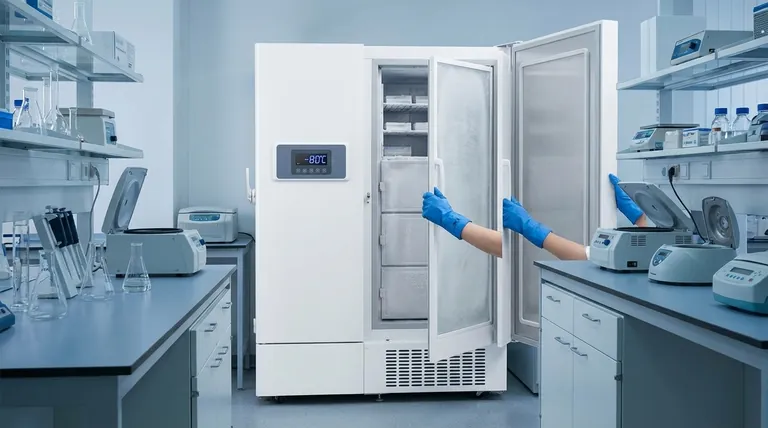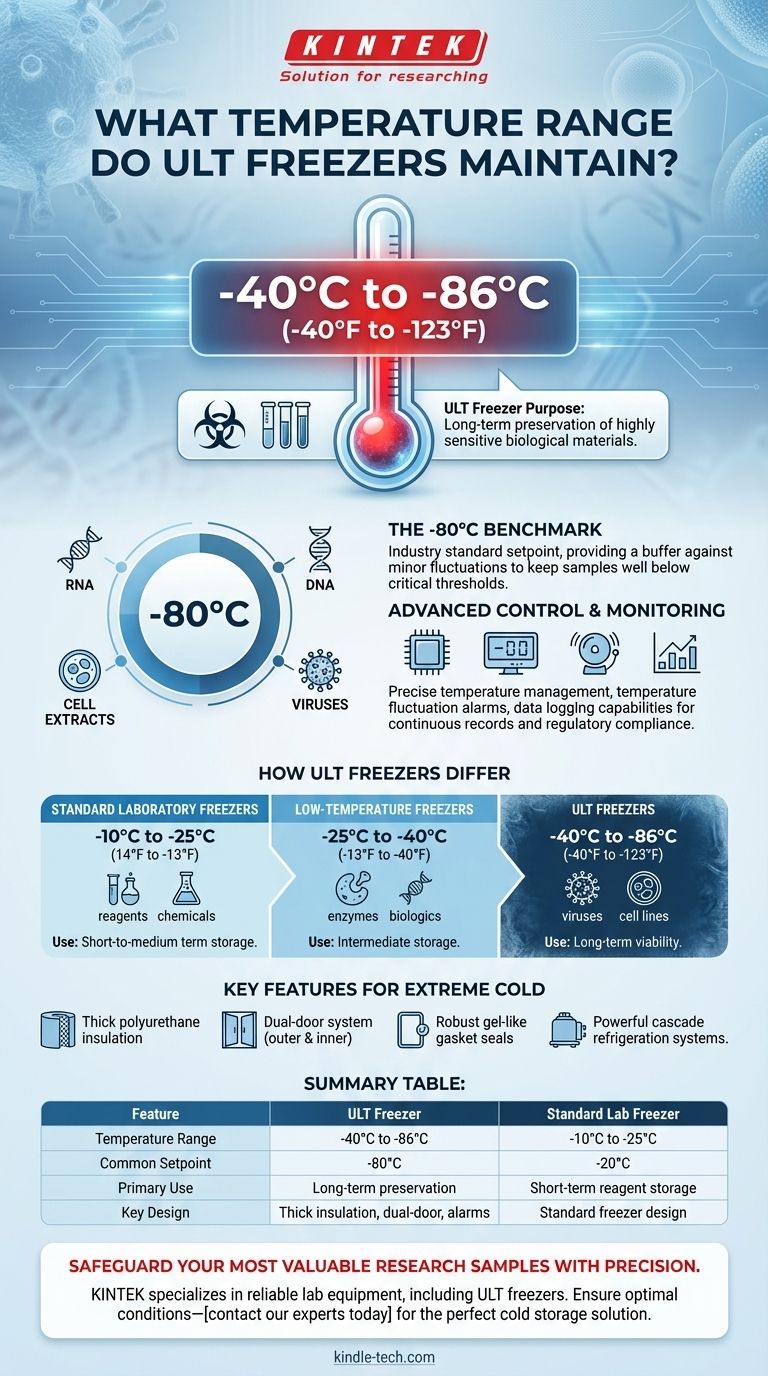At its core, an Ultra-Low Temperature (ULT) freezer maintains a temperature range between -40°C and -86°C. This is significantly colder than standard laboratory or medical freezers and is specifically engineered for the long-term preservation of highly sensitive biological materials.
The critical takeaway is that a ULT freezer is not just a colder freezer; it is a specialized piece of equipment designed to halt biological activity. Its ability to consistently maintain temperatures around -80°C is what separates it from standard units and makes it essential for modern research and medicine.

What Defines a ULT Freezer's Temperature?
The specific temperature range of a ULT freezer is a function of its intended purpose: the long-term, stable preservation of valuable biological samples. This requires not only reaching very low temperatures but maintaining them with exceptional precision.
The Core Operating Range
The most widely accepted and common operating range for a mechanical ULT freezer is between -40°C and -86°C (-40°F and -123°F).
While some models are rated for slightly different ranges, such as -60°C to -90°C, the vast majority of applications target a setpoint within this core window.
The "-80°C" Benchmark
You will often hear these units referred to simply as "-80 freezers." This has become the industry benchmark and the most common setpoint for preserving sensitive materials like RNA, DNA, viruses, and cell extracts.
Setting the freezer to -80°C provides a buffer, ensuring that even with minor temperature fluctuations from door openings, the samples remain well below critical temperature thresholds.
Advanced Control and Monitoring
Modern ULT freezers are equipped with sophisticated microprocessor controls for precise temperature management.
They also incorporate critical safety features like temperature fluctuation alarms and data logging capabilities. These systems provide a continuous record of temperature stability, which is essential for regulatory compliance and quality control.
How ULT Freezers Differ from Other Lab Freezers
Understanding the ULT freezer's role requires comparing it to other common types of cold storage found in a laboratory setting. The difference in temperature reflects a fundamental difference in purpose.
Standard Laboratory Freezers
A typical scientific or pharmacy freezer operates in the -10°C to -25°C (14°F to -13°F) range.
This is suitable for storing reagents, certain chemicals, and less sensitive biological samples for short-to-medium durations where simple freezing is sufficient.
Low-Temperature Freezers
A "low-temperature" freezer occupies the middle ground, with a range down to approximately -25°C to -40°C (-13°F to -40°F).
These units are used for samples that require colder storage than a standard freezer but do not need the extreme cold of a true ULT for long-term viability.
Understanding the Trade-offs and Key Features
Maintaining such extreme temperatures reliably requires specialized design and engineering, which comes with specific operational considerations.
The Role of Insulation and Sealing
To minimize heat transfer, ULT freezers feature thick walls filled with high-efficiency polyurethane insulation.
They are built with a dual-door system—an outer door and one or more inner doors—to reduce the influx of warm, moist air when accessing samples. The doors use robust, gel-like gasket seals to ensure an airtight closure.
Energy Consumption
Achieving and maintaining temperatures of -80°C is an energy-intensive process. These units contain powerful cascade refrigeration systems that represent a significant energy cost and heat output in a lab.
The Importance of Sample Integrity
The primary function of a ULT freezer is to protect irreplaceable samples. The investment in advanced insulation, secure seals, and precise monitoring is a direct trade-off made to guarantee the long-term integrity and viability of its contents.
Making the Right Choice for Your Samples
Selecting the correct cold storage is fundamental to successful research and clinical work. Your choice should be dictated entirely by the stability requirements of your materials.
- If your primary focus is short-term reagent storage: A standard laboratory freezer (-25°C) provides sufficient cooling without the high energy cost of a ULT.
- If your primary focus is intermediate storage of enzymes or certain biologics: A low-temperature freezer (-40°C) may be an appropriate and cost-effective choice.
- If your primary focus is long-term preservation of critical samples like RNA, viruses, or cell lines: A ULT freezer set to -80°C is the only acceptable industry standard.
Ultimately, choosing the right freezer is a critical step in safeguarding the integrity of your most valuable assets.
Summary Table:
| Feature | ULT Freezer | Standard Lab Freezer |
|---|---|---|
| Temperature Range | -40°C to -86°C | -10°C to -25°C |
| Common Setpoint | -80°C | -20°C |
| Primary Use | Long-term preservation of sensitive biologics | Short-term reagent storage |
| Key Design | Thick insulation, dual-door system, alarms | Standard freezer design |
Safeguard your most valuable research samples with precision. Choosing the right ultra-low temperature freezer is critical for the integrity of your RNA, DNA, viruses, and cell lines. KINTEK specializes in providing reliable lab equipment, including ULT freezers, to meet the exacting demands of modern laboratories. Ensure your samples are preserved under optimal conditions—contact our experts today to find the perfect cold storage solution for your needs.
Visual Guide

Related Products
- 808L Precision Laboratory Vertical Ultra Low Temperature Freezer
- 938L Vertical Ultra Low Temperature Freezer for Advanced Laboratory Storage
- 158L Precision Vertical Ultra Low Freezer for Laboratory Applications
- 408L Advanced Vertical Laboratory Ultra Low Temperature Freezer for Critical Research Material Preservation
- 108L Vertical Ultra Low Temperature ULT Freezer
People Also Ask
- What is an ultra-low temperature freezer? Protect Your Most Valuable Biological Samples
- What safety features are commonly found in ultra low temperature freezers? Ensure Sample Integrity with Advanced Protection
- What makes Ultra-Low Temperature freezers energy efficient? Key Design & Operational Strategies
- What temperature range do Ultra-Low Temperature freezers maintain? The -80°C Standard for Sample Integrity
- What are the key construction features of ultra low temperature freezers? Essential Design for Protecting Critical Samples



















